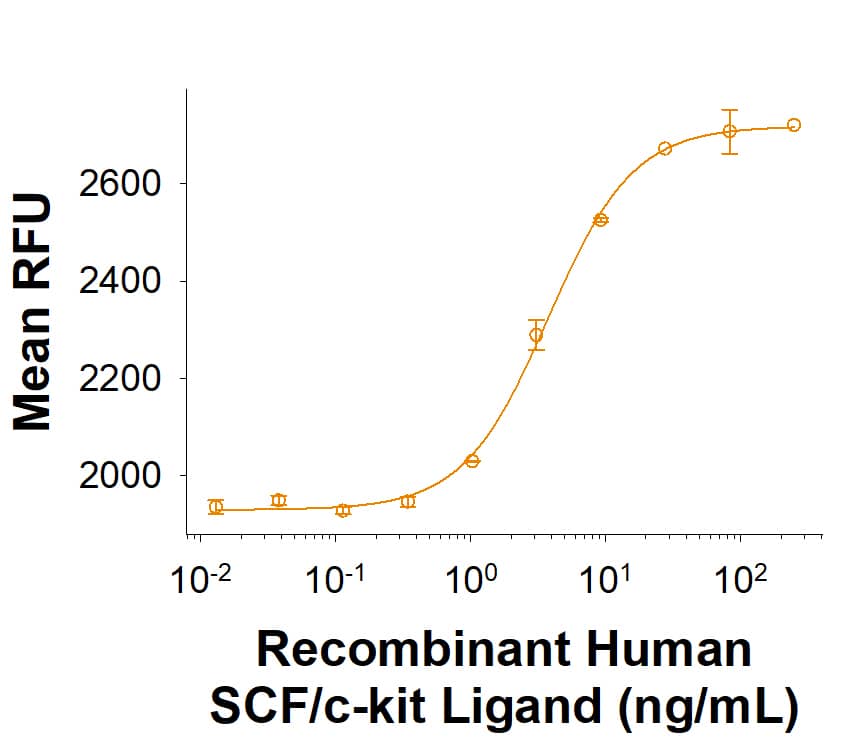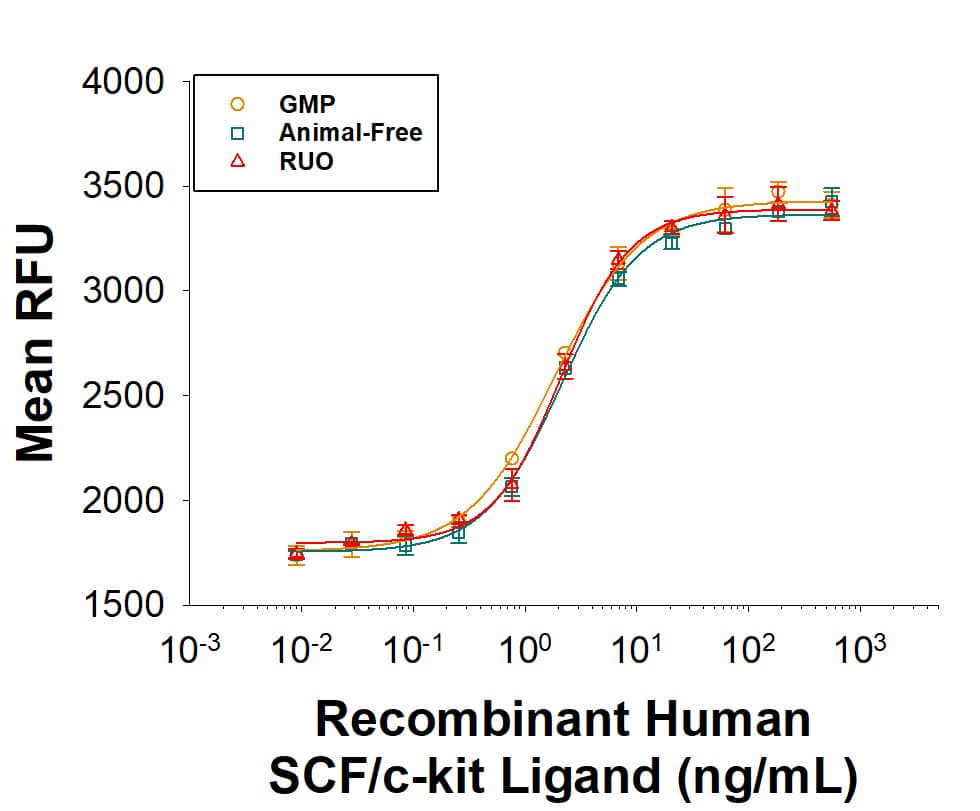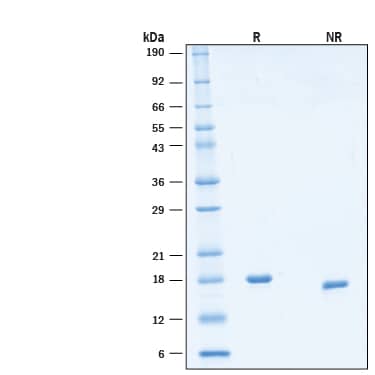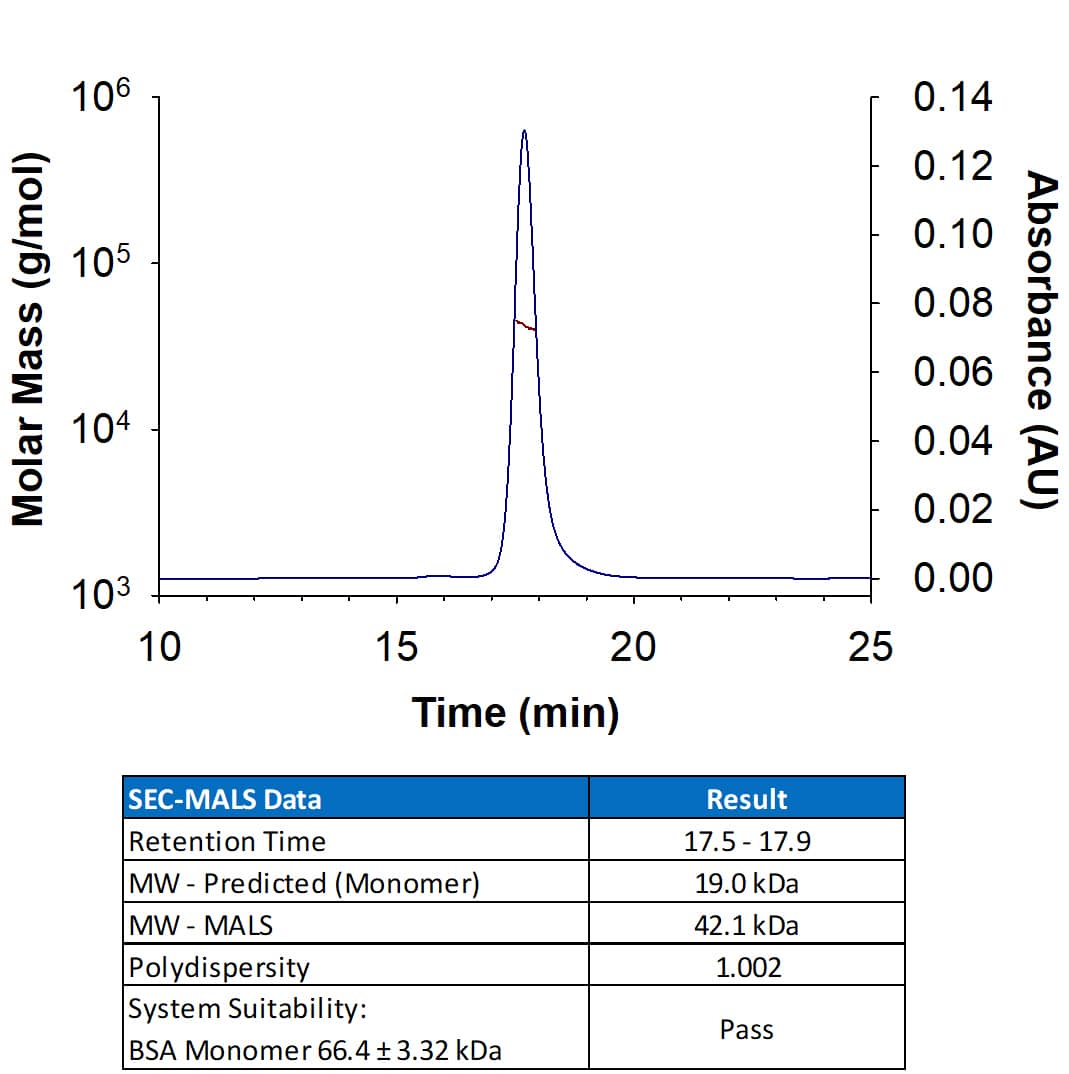Recombinant Human SCF Protein, CF Best Seller
R&D Systems, part of Bio-Techne | Catalog # BT-SCF

Key Product Details
Product Specifications
Source
Glu26-Ala189, with a N-terminal Met
Purity
Endotoxin Level
N-terminal Sequence Analysis
Predicted Molecular Mass
SDS-PAGE
Activity
The ED50 for this effect is 1.00-8.00 ng/mL.
Scientific Data Images for Recombinant Human SCF Protein, CF
Recombinant Human SCF/c‑kit Ligand Protein SEC-MALS.
Recombinant Human SCF Protein (Catalog # BT-SCF) has a molecular weight (MW) of 42.1 kDa as analyzed by SEC-MALS, suggesting that this protein is a homodimer.Recombinant Human SCF/c‑kit Ligand Protein Bioactivity.
Recombinant Human SCF/c kit Ligand (Catalog # BT-SCF) stimulates cell proliferation of the TF-1 human erythroleukemic cell line. The ED50 for this effect is 1.00-8.00 ng/mL.Equivalent Bioactivity of GMP, Animal-Free, and RUO grades of Recombinant Human SCF.
Equivalent bioactivity of GMP (BT-SCF-GMP), Animal-Free (BT-SCF-AFL) and RUO (Catalog # BT-SCF) grades of Recombinant Human SCF as measured in a cell proliferation assay using TF-1 human erythroleukemic cells (orange, green, red, respectively).Formulation, Preparation and Storage
BT-SCF
| Formulation | Lyophilized from a 0.2 μm filtered solution in PBS with Trehalose. |
| Reconstitution | Reconstitute the 10 μg size at 100 μg/mL in PBS. Reconstitute all other sizes at 500 μg/mL in PBS. |
| Shipping | The product is shipped at ambient temperature. Upon receipt, store it immediately at the temperature recommended below. |
| Stability & Storage | Use a manual defrost freezer and avoid repeated freeze-thaw cycles.
|
Background: SCF/c-kit Ligand
Stem cell factor (SCF), also known as c-kit ligand (KL), mast cell growth factor (MGF), and steel factor (SLF), is a widely expressed 28‑40 kDa type I transmembrane glycoprotein (1). It promotes the survival, differentiation, and mobilization of multiple cell types including myeloid, erythroid, megakaryocytic, lymphoid, germ cell, and melanocyte progenitors (1‑7). SCF is a primary growth and activation factor for mast cells and eosinophils (8). Mature human SCF consists of a 189 amino acid (aa) extracellular domain (ECD), a 23 aa transmembrane segment, and a 36 aa cytoplasmic tail (9). The ECD shows both N‑linked and O-linked glycosylation (10). Proteolytic cleavage at two alternate sites in the extracellular juxtamembrane region releases a 25 kDa soluble molecule which is comparable to the only form produced by Steel-dickie mutant mice (11, 12). An alternately spliced isoform of human SCF lacks 28 aa that encompasses the primary proteolytic recognition site (13). Within the ECD of the long isoform (corresponding to this recombinant protein), human SCF shares 79%‑87% aa sequence identity with canine, feline, mouse, and rat SCF. Rat SCF is active on mouse and human cells, but human SCF is only weakly active on mouse cells (9). Noncovalent dimers of transmembrane or soluble SCF interact with the receptor tyrosine kinase SCF R/c‑kit to trigger receptor dimerization and signaling (14).
SCF assists in the recovery of cardiac function following myocardial infarction by increasing the number of cardiomyocytes and vascular channels (15). SCF is a versatile factor in the differentiation of many specific cell types like spermatogonial stem cells (16) and megakaryocyte progenitors (17). Apart from differentiation, SCF also can maintain stemness in cells. This is the case for human bone marrow mesenchymal cells, which require SCF and hepatocyte growth factor for maintenance (18). Hematopoietic stem cells similarly require SCF from surrounding cells in their niche to maintain their stemness and their progenitors (19). SCF has also improved protocols for continuous generation of cells in culture systems, like granulocytes and macrophages (20).
For treatment of graft versus host disease, SCF is used in combination with other cytokines to generate myeloid-derived suppressor cells from human umbilical cord blood (21). SCF is also used to generate T cells for cell-based therapies, drug screening and disease modeling (22). In regenerative studies, SCF is applied in wound healing hydrogel as a means of increasing its adhesion strength and tissue regeneration (23).
References
- Ashman, L.K. (1999) Int. J. Biochem. Cell Biol. 31:1037.
- Sette, C. et al. (2000) Int. J. Dev. Biol. 44:599.
- Yoshida, H. et al. (2001) J. Invest. Dermatol. Symp. Proc. 6:1.
- Erlandsson, A. et al. (2004) Exp. Cell Res. 301:201.
- Kapur, R. et al. (2002) Blood 100:1287.
- Wang, C.-H. et al. (2007) Arterioscler. Thromb. Vasc. Biol. 27:540.
- Bashamboo, A. et al. (2006) J. Cell Sci. 119:3039.
- Reber, L. et al. (2006) Eur. J. Pharmacol. 533:327.
- Martin, F.H. et al. (1990) Cell 63:203.
- Arakawa, T. et al. (1991) J. Biol. Chem. 266:18942.
- Majumdar, M.K. et al. (1994) J. Biol. Chem. 269:1237.
- Brannan, C.I. et al. (1991) Proc. Natl. Acad. Sci. 88:4671.
- Anderson, D.M. et al. (1991) Cell Growth Differ. 2:373.
- Lemmon, M.A. et al. (1997) J. Biol. Chem. 272:6311.
- Kanellakis, P. et al. (2006) Cardiovasc. Res. 70:117.
- Nasimi, M. et al. (2021) Reprod Sci. 28:963.
- Krisch, L. et al. (2021) Int. J. Mol. Sci. 22:8224.
- Cao, Z. et al. (2020) Stem Cell Res Ther. 11:1.
- Comazzetto, S. et al. (2019) Cell Stem Cell. 24:477.
- Bernecker, C. et al. (2019) Stem Cells Dev. 28:1540.
- Park, M.Y. et al. (2019) Front Immunol. 10:1.
- Netsrithong, R. et al. (2020) Stem Cell Res Ther. 11:1.
- Zhang, Li. et al. (2021) Journal Mater Chem B. 29: 5887.
Long Name
Alternate Names
Gene Symbol
UniProt
Additional SCF/c-kit Ligand Products
Product Documents for Recombinant Human SCF Protein, CF
Product Specific Notices for Recombinant Human SCF Protein, CF
For research use only



